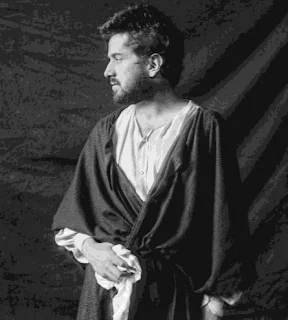Peacock & Vine: On William Morris and Mariano Fortuny by A.S. Byatt: A Review
Fortuny’s Palazzo Pesaro Orfei in Venice is a warren of dark spaces imbued with the rich hues of Asia. In his attic workshop, Fortuny created intricate designs from glowing silks and velvets; in the palazzo he found “happiness in a glittering cavern” alongside the French model who became his wife and collaborator, including on the famous “Delphos” dress—a flowing, pleated gown that evoked the era of classical Greece.
Morris’s Red House outside London, with its Gothic turrets and secret gardens, helped inspire his stunning floral and geometric patterns; it likewise represented a coming together of life and art. But it was a “sweet simple old place” called Kelmscott Manor in the countryside that he loved best—even when it became the setting for his wife’s love affair with the artist Dante Gabriel Rossetti.
Generously illustrated with the artists’ beautiful designs—pomegranates and acanthus, peacock and vine—among other aspects of their worlds, this marvel-filled book brings the visions and ideas of Fortuny and Morris to vivid life.
- Hardcover: 192 pages
- Publisher: Knopf (August 2, 2016)
- Language: English
- ISBN-10: 1101947470
- ISBN-13: 978-1101947470
"Every time I thought about Fortuny in the aquamarine clarity, I found I
was also thinking about the Englishman William Morris. I was using Morris, whom
I did know, to understand Fortuny. I was using Fortuny to reimagine Morris.
Aquamarine, gold green. English meadows, Venetian canals. I closed my eyes and
found my head full of aquamarine light, water flowing in canals, the dark of
the Palazzo Pesaro Orfei." A.S. Byatt
"They were both men of genius and extraordinary energy. They created
their own surroundings, changed the visual world around them,studied the forms
of the past and made them parts of new forms. In many ways they were opposites.
Morris was an English bourgeois whose father had made an unexpected fortune in
tin mining. He became a convinced and passionate socialist. Fortuny came from
an aristocratic Spanish family of painters and artists and lived in an elegant
aristocratic world. Fortuny’s imaginative roots were Mediterranean-North
Africa, Crete and Delphos. Morris was obsessed by the North and the Nordic-the Icelandic
sagas, Iceland itself, the North Sea." A.S. Byatt
In Peackock & Vine Byatt divides chapters of both men according to physical, descriptive geographical location, four directions: North, South, East, and West, as well as the houses they lived in. For instance, Morris's homes are mentioned by name. Fortuny's Venetian family Palazzo Pesaro Orfei made me yearn to be there if only for a few minutes.
What I found so very refreshing was in the case of William Morris, Byatt does not go over old ground. For instance, there is only the briefest mentions of his personal life, his wife, Jane Morris, etc. Cleverly, Byatt juxtaposes aspects of their own individuality and creativity through describing their travels thus affecting their own works. For instance, Morris created his written prose through his own Kelmscott Press as well as his wallpapers and paintings.
Mariano Fortuny, whom I did not know until Peacock & Vine used his Mediterranean influences to create his works of fabrics, clothing designs using natural light to infuse his vision. He became one of Venezia's most influential fashion designers. His muse was a woman who worked with him for twenty-two years, Henrietta, who became his wife. It was incredible learning how her creativity and vision influenced his and how they worked together. He also drew and photographed her but he would be known for his fashion.
Overall, A.S. Byatt writes of her own personal favorite works and pieces of Morris and Fortuny's that she owns. She discusses how these men influenced her so much so that she had to write this gem of a booklet under two-hundred pages. I am so glad I was able to read an online digital review copy. It gave me a chance to learn so much about two creative geniuses that really weren't that different.
Peacock & Vine by A.S. Byatt is published now in the United Kingdom, Amazon UK
Peacock & Vine by A.S. Byatt will be published in the United States on August 2, 2016, pre-order your copy, Amazon



Comments
I love the cover!
The old photographs are splendid, so clear and detailed. In some ways far superior to digital I think.
I know you will both enjoy Peacock & Vine as much as I have. Thanks so much for stopping by! :)